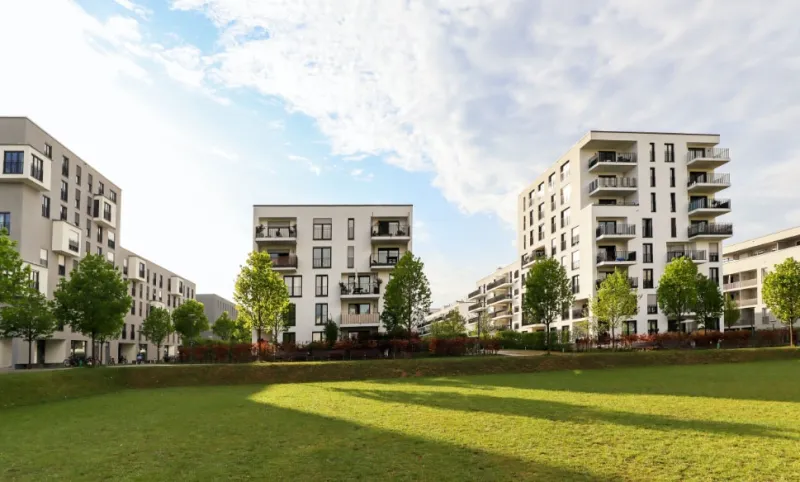
ESG in Real Estate
Institutional investors and their stakeholders are no strangers to ESG – in fact, you could say they’ve been among the primary drivers in the movement to invest in a manner that focuses on the environment, societal issues, and corporate governance. Of late, diversity and inclusion – a specific area that falls under “S” and “G” – has increasingly been added to mandates when asset allocators are assessing asset managers.
What started out as negative screening of stocks has evolved into a much more sophisticated realm of investment strategies, particularly as institutional appetites for alternative investments have increased. Under the broad heading of alternatives, one opportunity for sustainable allocations that can fly under the radar is essential housing – but it’s gaining increased notice from investors.
This brief report looks at how essential housing can meet part of the ESG demand institutional investors need to fulfill on behalf of their constituencies in a way that is brimming with potential. As you’ll see, ESG attributes in essential housing must cover three core areas – the properties themselves, the investment operations, and the day-to-day business of the corporations behind essential housing.
What’s Essential Housing?Essential housing is a product for households earning more than 60% of an area’s median income (AMI), putting them above the cutoff for a public housing subsidy, but less than 140% of that AMI, putting them below the threshold to afford luxury housing. The U.S. housing market is 5.24 million homes short of what is needed to meet demand, according to a recent report from Realtor.com. Freddie Mac estimates there has been a 52% rise in the nation’s home shortage since 2018, with most of this shortage in essential housing. In addition, over the last five years, roughly 75% of the new housing product built in the multifamily market was luxury housing, further amplifying the shortage in essential housing. The essential housing gap is influenced heavily by the growing demographic demand from the large Millennial and Gen Z generations who are already in, or just entering, the workforce. The pandemic has only exacerbated the problem. |
All Grubb Properties and Link Apartments℠ employees operate under five guiding principles: Integrity, Respect, Timely Decision Making, Fair Dealing, and Continuous Improvement. These principles are embedded in Grubb Properties’ corporate governance, including its approach to diversity, equity, and inclusion (DEI).
One vision: DEI
Grubb Properties’ unifying vision is to work together to enhance life and community. To make this vision a reality, the firm is committed to attracting and engaging a workforce that is diverse, while creating an equitable culture in which everyone has an equal opportunity to belong and build a career. By hiring and recruiting the best and brightest, embracing and respecting each other’s differences, and fostering an environment of respect and acceptance, Grubb Properties believes it will enhance the lives of its team members and the communities they live and work in, and the experience of its stakeholders.DEI is central in all Grubb Properties’ business practices and at every step of its business cycle. The Board of Directors expects company leaders at all levels to help create and sustain a culture where everyone has equal opportunity. For example, Grubb Properties team members with disabilities have access to technology, resources, and training for a barrier-free workplace. Managers are held accountable for DEI training, performance, and behavior in annual performance assessments.
To evaluate the effectiveness of its hiring practices and employee retention initiatives, employee and management statistics that track trending gender and ethnicity data are reported annually and presented to Grubb Properties’ Board of Directors and senior management. The report also includes a gender and ethnicity pay equity assessment comparing salary and bonus data across departments and by career stage. No incidents of discrimination were reported in 2020.
As part of a commitment to pay equity, Grubb Properties conducts regular compensation and promotion reviews to help ensure employees are treated fairly, regardless of their gender, race, ethnicity, religion, and sexual orientation or identification.
To make great strides in DEI, it’s important to fill the talent pipeline. To improve diversity representation at the company, Grubb Properties has increased recruiting at Historically Black Colleges and Universities (HBCUs), and partners with internship programs devoted to underrepresented talent to fill both full-time roles and internships. The company continues to implement many other initiatives to reinforce the diversity of its workforce and foster an inclusive workplace.
Grubb Properties also conducts an annual survey of employees to measure perceptions of the company’s inclusiveness. In the most recent survey administered in August 2020, the overall satisfaction score related to inclusiveness was 4.7 out of 5.
Moving forward, Grubb Properties will continue to track its performance annually with the goal of addressing areas identified as needing improvement, and consistently explore how the firm can use best practices to advance DEI. One example is a requirement that all team members undertake diversity and inclusion training during onboarding and annually thereafter.
Grubb Properties believes ESG principles and effective risk management will become even more important to investors and other stakeholders in the coming years, and the company is committed to continuing to pursue such principles and have a positive impact on the communities it creates and serves.
Acquisitions/Dispositions: When evaluating the potential acquisition and disposition of properties, Grubb Properties identifies and quantifies climate-related risk. New assets with unacceptably high exposure to natural disaster risk are declined. The same climate-risk data is used to determine whether the firm should divest or adapt assets purchased years ago when climate-risk assessments didn’t reflect current realities.
To create a disciplined and replicable process at Grubb Properties, underwriting and research functions are separate from acquisitions. Research is developed using internal resources, subscription services and through third-party contracts. As part of the evaluation process, a third-party review is conducted of environmental and building conditions, and experienced specialists review any specific concerns raised in the initial evaluation.
Further, a separate engineering consultant is hired to evaluate a property’s energy efficiency potential with capital improvements. Once the evaluation (including a specific environmental score) is complete, the final investment decision is made by an investment committee composed of eight senior Grubb Properties executives. The committee convenes on a weekly basis to review and discuss all active pipeline opportunities and follows a proprietary nine-step approval process from initial evaluation to post-investment after-action review.
Grubb Properties is aware that climate change repercussions will increase displacement, migration, gentrification, and affordability challenges in the markets where it operates, so it closely monitors the availability of attainable housing and local housing shortages in these markets to identify where it can provide supply to meet the demand.
Development/Construction: During the development phase, surface water and aquatic ecosystems are protected by controlling and retaining construction pollutants. Waste is managed by diverting reusable vegetation, rocks, and soil, as well as construction and demolition materials, from disposal. As a rule, Grubb Properties exceeds code to handle increased storm water runoff and increased risk of water intrusion. Correcting storm water issues, including water quality and water quantity measures, helps address urban flooding and improve regional water quality. Once a property is operational, Grubb Properties protects and restores habitats and soils that were disturbed during construction.
Fully aware that ESG permeates the supply chain, Grubb Properties collaborates with its development partners to include sustainability strategies in the design phase on a project-level basis. Many Grubb Properties partners and vendors participate in its supply chain survey on ESG priorities and policies.
Every month, senior leadership at Grubb Properties reviews a Risk Rankings Report for each asset in the standing portfolio. This report includes an environmental risk score, among several other factors, and informs decisions at both the asset and the entity levels. This allows Grubb Properties to create action plans to mitigate new or persistent risks, including targeted capital improvements and operational changes. Priorities are identified based on historical cases of identified risks cross-compared to the asset’s value in proportion to the entire portfolio. A prime example is addressing climate change’s increased flood risk in low-lying coastal areas. Grubb Properties is increasing its flood modeling and analysis to account for fluvial and storm surge flooding, and at its standing investments flood sensors and new water barriers have been installed. As climate risk is updated and reassessed, Grubb Properties avoids new acquisitions in these areas.
Additionally, energy efficiency, water efficiency, and GHG emissions are analyzed quarterly to identify leaders and laggards in the portfolio. Waste management and tenant health risks are addressed in the same effort. Outliers or properties with significant year-over-year variance are examined more closely by the Grubb Properties sustainability, maintenance, and property management teams to identify remediation strategies. The risks are identified at a property level and then brought to executive leadership to discuss remediation and expeditiously mitigate the concern.
Pillars of ResilienceResilience is the heart and soul of sustainability. Informed by decades of experience and extensive research, Grubb Properties has identified five core pillars of resiliency that allow it to select locations best equipped to handle inevitable downturns.
|
Grubb Properties’ primary solution to the nationwide housing crisis is its Link Apartments℠ product, which focuses on intelligent design and resident amenities to provide a lower cost, urban infill living opportunity. There are currently 19 Link Apartments℠ communities stabilized or under construction in 11 cities nationwide, totaling 4,935 multifamily units.
As a vertically integrated real estate fund manager and developer, Grubb Properties acquires, develops, and manages these communities so it can ensure quality throughout each community’s lifecycle. In developing Link Apartments,℠ the focus is on two key differentiators: location and price point. Grubb Properties selects urban locations near community amenities, transit options, and major counter-cyclical employment anchors such as universities and medical centers. It also targets rents that are affordable to residents earning 60-140% of area median income.
Grubb Properties achieves those prices in its target locations – where virtually no other multifamily product is being developed at a similar price segment – by driving value through innovative site acquisition, shared parking, tax incentives, grants, and other proven methods. For example, Grubb Properties focuses on six highly efficient floor plan types across its communities. The industry standard often includes more than 25 unit types, which can add cost and an inefficient work process that takes more time.
Leveraging ESG
Grubb Properties views sustainability and ESG as an investment tool that can drive down the recurring cost of utilities for its residents while protecting the environment and improving the communities in which it operates. The firm’s emphasis on essential housing has environmental stewardship and efficiency embedded in its DNA.To meet the needs of those who earn between 60% and 140% of area median income, Grubb Properties constantly looks for ways to make its communities more cost-effective, efficient and clean. Because Grubb Properties holds and operates its properties with a projected timeframe of at least 10 years, it eschews shortcuts that may look impressive in the short term but don’t hold up long term.
Through creative and progressive building and unit design, Link Apartments℠ are built from the ground up for efficiency. Working with six fundamental floor plans is beneficial on the construction side, project management side, and to the resident experience. For example, every apartment maximizes its space, providing apartments that “live larger” than the nominal square footage might imply.
6 Innovations You Should Know AboutAs a vertically integrated fund manager, Grubb Properties can craft innovations with effects that resonate throughout its strategy, portfolio, and each asset’s life cycle. Here are its six most impactful innovations:
|
At its building sites, Grubb Properties is sensitive to environmental concerns including biodiversity preservation, soil impact minimization, and pollution mitigation at Brownfield sites. Regionally appropriate, drought-resistant, and pollinator-friendly landscaping is consistently implemented, along with designs that mitigate risks and damage from location-specific weather and natural disasters.
ESG on the move
With sites near greenways and other established public transportation options, Link Apartments’℠ residents can readily minimize their car usage. Grubb Properties provides state-of-the-art cycle centers in all its communities and encourages electric vehicle use by providing EV chargers.As part of environmental oversight at the property level, internal and third-party reviews of utility data and maintenance practices ensure that high-performance building efficiency is maintained during the life of the asset. Strategies include systematic retro-commissioning, preventative maintenance, and regular year-over-year internal and external utility benchmarking. In addition, Grubb Properties property managers undergo regular ESG training and self-assessments, and utility consumption is a topic included on every property manager’s annual evaluation.




